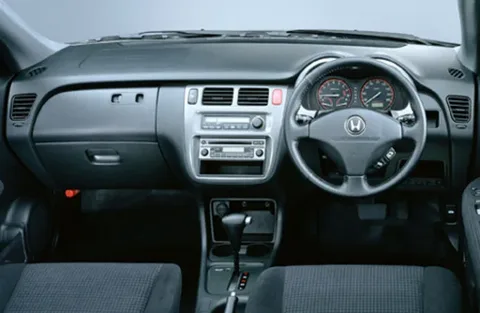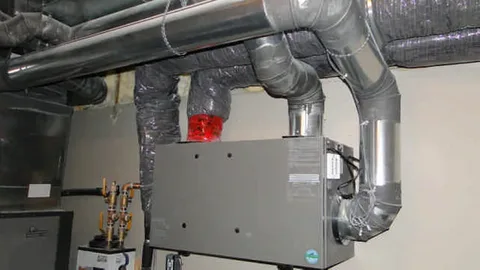Are you looking for a way to improve the air quality in your home while saving on energy costs? Look no further than the HRV-system. In this blog post, we will explore the benefits of installing an HRV system, how to choose the right one for your home, decipher heat-recovery ventilator specifications, the installation process, tips for optimising efficiency, maintenance tips, financing options, and what to expect in terms of price range.
The Benefits of Installing an HRV-System
An HRV-system stands out for its dual capacity to enhance the indoor environment and manage energy expenditure efficiently. The core advantage lies in its ability to recuperate heat from exhausted air, thereby minimising energy loss and reducing heating costs during cooler months.
This process ensures a consistent supply of fresh, filtered air, mitigating airborne contaminants such as dust, pollen, and other allergens. The result is a significant improvement in indoor air quality, leading to healthier living conditions and reducing the likelihood of respiratory issues and allergies.
The system combats humidity levels, thereby curbing the potential for mould development and eliminating musty odours, which are common in poorly ventilated spaces. The strategic introduction of fresh air and extraction of stale air contribute to a more pleasant and comfortable indoor climate, making the HRV-system an indispensable tool for achieving a healthier, more energy-efficient home without compromising comfort.
 How to Choose the Right HRV-System for Your Home
How to Choose the Right HRV-System for Your Home
Selecting the optimal HRV-system for your residence requires carefully considering several pivotal factors. Assess the square footage of your home, as a system’s capacity to effectively circulate air is contingent upon its compatibility with the space it serves. A unit too small will be overtaxed, reducing efficiency and longevity, while an overly large system can lead to unnecessary energy consumption and expense.
Equally crucial is examining your household’s specific requirements. The number of occupants, the presence of pets, and lifestyle activities that influence indoor air quality should guide your selection. An HRV-system that accommodates these variables will ensure a balanced indoor environment tailored to your family’s needs.
Budgetary constraints also play a significant role in the decision-making process. While opting for a less expensive model is tempting, consider the unit’s energy efficiency ratings and potential long-term savings on heating costs. Investing in a higher-efficiency model can result in lower utility bills over time, offsetting the initial outlay.
Deciphering Heat Recovery Ventilator Specifications
Understanding the specifications of a heat recovery ventilator (HRV) is crucial in selecting the right system for your home. These specifications can sometimes seem complex, but they are essential for ensuring the system meets your ventilation needs whilst operating efficiently. The key specifications include Heat Recovery Efficiency (HRE), airflow rate, noise level, and energy consumption.
Heat Recovery Efficiency (HRE) is a critical parameter that indicates the percentage of heat from outgoing air that the HRV-system can transfer to the incoming cold air. A higher HRE means more effective heat transfer and better energy savings. Look for an HRV with an HRE of at least 75% to ensure substantial energy efficiency. The airflow rate, measured in litres per second (L/s) or cubic metres per hour (m³/h), signifies the volume of air the HRV-system can ventilate.
Your choice should align with the size of your property and its specific ventilation requirements to ensure adequate air exchange. Noise level is another important consideration, as HRV-systems are continuously operational. Select a unit with a low decibel (dB) rating to maintain a quiet and comfortable indoor environment. Modern HRVs are designed to be unobtrusive, but checking the noise specification is always prudent.
The Installation Process Explained
Embarking on the installation of an HRV-system is a task that necessitates professional expertise to ensure it integrates seamlessly with your home’s infrastructure. The process begins with identifying a central location within your home for the main unit, allowing for efficient ductwork connection and optimal air circulation.
From there, specialists will lay out and install a network of ducts, ensuring each room is equipped with appropriate air intake and exhaust vents. The complexity and duration of this process can be influenced by the unique characteristics of your house, such as its size, layout, and the existing ventilation system.
For this reason, a tailored installation plan developed by a seasoned HVAC professional is indispensable. They will account for the physical attributes of your home and consider the best routes for ductwork to minimise disruption and maximise efficiency. Engaging with professionals from the outset guarantees that the system’s installation achieves the highest standards, optimising its performance and longevity.
Optimising Efficiency: Tips for Using Your HRV-System
To harness the full potential of your HRV-system, several strategies can enhance its efficiency and contribute to a more healthful and energy-conscious home environment. Ensuring that the system’s settings are appropriately adjusted for different seasons is pivotal. During colder months, the HRV-system can be set to retain more heat, whereas in warmer periods, it might be beneficial to adjust settings for optimal cool air circulation.
Integrating your HRV-system with other home ventilation techniques can further augment air quality. On days when outdoor conditions are favourable, combining your HRV with natural ventilation methods, such as opening windows, can introduce additional fresh air and reduce the load on your system.
Attention should be given to the system’s operation during high humidity levels or when indoor activities produce excess moisture, such as cooking or showering. Utilising your HRV-system to expel humid air efficiently and maintain balanced indoor humidity levels can prevent condensation and mould growth, safeguarding the structural integrity of your home and the health of its inhabitants.
Maintenance Tips to Keep Your HRV-System Running Smoothly
Ensuring your HRV-system operates at its peak performance is critical for maintaining your home’s air quality and energy efficiency. Regular maintenance can prevent potential issues, extend the lifespan of your system, and ensure it continues to run smoothly.
Regular Filter Cleaning/Replacement
The filters in your HRV-system play a crucial role in purifying the incoming air and preventing debris from entering your home. Check filters every three to six months and clean or replace them. A clogged filter can reduce the system’s efficiency and compromise air quality.
Inspect and Clean Vents and Ducts
Ensure that all vents and ducts connected to your HRV-system are free from obstruction. Annually inspect these pathways for blockages, such as dust build-up or debris, which can impede airflow and reduce the system’s effectiveness. Gentle cleaning with a vacuum or a soft brush can help maintain optimal airflow.
Check the Heat Exchanger
The heat exchanger is the heart of your HRV-system, facilitating heat transfer between incoming and outgoing air streams. To maintain its efficiency and prolong its useful life, it should be inspected at least once a year for signs of wear or damage and cleaned according to the manufacturer’s instructions.
Evaluate System Settings and Controls
Please familiarise yourself with the system’s settings and periodically check to ensure they are optimally configured for current weather conditions. Adjustments might be necessary to accommodate seasonal changes, ensuring your HRV-system provides the desired level of comfort and efficiency throughout the year.
Financing Options for Your HRV-System
Navigating the financial aspect of acquiring an HRV-system is a critical step towards making this environmentally and health-conscious choice for your home. Given the variability in prices, which can span from a modest sum to a more significant investment depending on the model and its features, it’s essential to explore the range of financing avenues available.
Many suppliers and manufacturers recognise the importance of making these systems accessible and offer tailored financing plans to alleviate homeowners’ immediate financial burden. These plans often feature competitive interest rates and manageable monthly payments, making integrating an HRV-system into your household easier without straining your budget.
Investigating any available rebates, grants, or incentives offered by government bodies or environmental organisations is worthwhile. Such initiatives are frequently launched to encourage the adoption of energy-efficient technologies in residential settings, potentially offering substantial savings on purchasing and installing an HRV-system. Engaging in thorough research or consulting with a professional can uncover these opportunities, potentially reducing the overall cost and making the investment in an HRV-system more attainable.
HRV Price Range: What to Expect
Navigating the HRV-price spectrum is essential for homeowners considering this investment, as the cost can vary significantly based on the system’s size, features, and efficiency. Generally, the market for HRV-systems spans from entry-level models priced around £500 to £600, suitable for smaller homes or flats, to high-end units that can exceed £2,000, designed for larger properties or those requiring advanced features and higher efficiency rates.
The mid-range HRV price, typically between £800 and £1,200, offers a balance of cost and performance, making it a popular choice for the average household. These systems usually provide a good compromise between energy efficiency and operational capabilities, fitting the needs of most homes without overextending the budget.
It’s important to factor in the initial purchase price and installation costs, which can vary depending on the complexity of your home’s existing ventilation system and the amount of ductwork needed. Professional installation can range from £500 to over £1,000, influencing the total expenditure. Choosing a system within your budget that doesn’t skimp on quality is crucial. While the upfront HRV-price might seem steep, the potential energy savings and improved air quality can offer significant long-term benefits.
Conclusion
In summary, integrating an HRV-system greatly complements the journey towards a healthier, more energy-efficient home. This innovative solution champions superior indoor air quality and aligns with the growing emphasis on sustainability and cost-efficiency in domestic settings. Whilst the initial outlay and selection process might seem daunting, the long-term benefits of enhanced comfort and reduced energy expenses underscore the value of this investment. As we strive for homes that nurture well-being and environmental stewardship, the HRV-system emerges as a pivotal addition to modern living spaces.
FAQs
How does an HRV-system work?
An HRV-system draws fresh air from the outside and expels stale indoor air. Inside the system, a heat exchanger transfers heat from the outgoing air to the incoming air. This process reduces the energy required to heat or cool the indoor space, maintaining comfortable temperatures while ensuring fresh air circulation.
What are the benefits of installing an HRV-system?
The benefits of installing an HRV-system include improved indoor air quality, reduced energy costs, and enhanced overall comfort. By continuously supplying fresh air and removing contaminants, and HRV-system helps to create a healthier living environment. The heat recovery feature also lowers heating and cooling expenses.
Is an HRV system suitable for all types of homes?
An HRV system suits most homes, especially well-insulated and airtight dwellings. In newer, energy-efficient homes where natural ventilation is limited, an HRV-system can be particularly beneficial. However, older homes with drafts might require additional modifications to benefit fully from an HRV-system.
How often should an HRV-system be maintained?
Regular maintenance is crucial for an HRV-system to function effectively. Filters should be checked and cleaned every three to six months, and the heat exchanger should be inspected annually. Ensuring that the system is free from blockages and operating efficiently helps prolong its lifespan and maintain optimal performance.
Can an HRV-system be integrated with existing HVAC systems?
Yes, an HRV-system can be integrated with existing HVAC systems. It works with your current heating and cooling systems to provide balanced ventilation and heat recovery. Professional installation is recommended to ensure proper integration and maximize the efficiency of both systems.
| Other Good Articles to Read |
| skank blogs |
| unreal blogs |
| tba blogs |
| all city forums |
| dany blogs |
| refuge blogs |
| the music blogs |
| key forums |
| the big blog theory |
| joe blogs |
| blogs 4 me |
| Blogs Emon |
| Related Business Listings |
| Contact Directory |
| Local Business Profiles |



